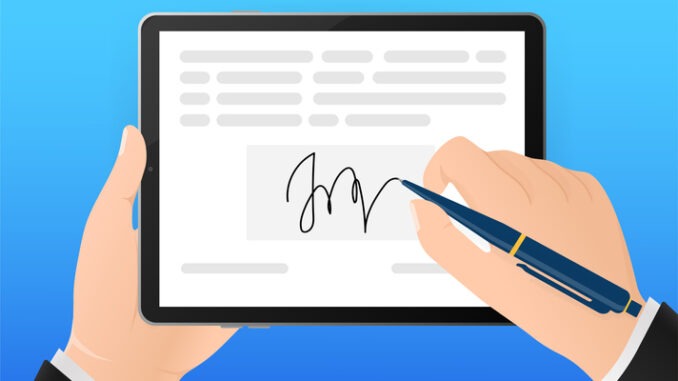Dealing with stacks of paperwork can be a cumbersome task for any business, consuming valuable time and effort. Fortunately, the digital era brings a solution – electronic signatures, commonly known as e-signatures. In this article, we’ll delve into the world of e-signatures, exploring what they are, how they work, and the transformative benefits they offer
CREDIT: This is an edited version of an article that originally appeared on SME News
Electronic signatures, or e-signatures, serve as a digital alternative to traditional handwritten signatures. These are any sound, symbol, or method logically associated with a document, indicating the signer’s agreement with its content. Unlike the traditional method of physically signing papers, e-signatures leverage digital processes to streamline transactions and enhance efficiency.
How do you use e-signatures?
The process of using e-signatures is remarkably straightforward. First, the document requiring a signature is converted into a digital format, such as a PDF, Word document, website form, or image file. The signer is then prompted to apply their e-signature using various methods – typing a name, drawing on a touchscreen, uploading a pre-saved signature image, or using a digital ID for authentication. Once signed, the document is timestamped with crucial details like the date, time, and signer’s identity, providing digital proof of intent and acceptance.
The key benefits of e-signatures
- Increased efficiency: E-signatures eliminate the need for printing, scanning, mailing, and storing physical documents, resulting in significant time and cost savings.
- Convenience: Signatures can be executed from anywhere using desktops, tablets, or smartphones, providing added flexibility to businesses.
- Speed: Digital workflows enable simultaneous reviews and near-instant signing, allowing documents to move swiftly compared to traditional mail processes.
- Security: E-signature solutions prioritise document security, using advanced features like audit trails to ensure document integrity.
- Legality: Laws such as ESIGN and UETA establish the legal validity of e-signatures, equating them with handwritten signatures.
- Collaboration: Shared signing enables multiple signers to review, sign, and pass documents electronically from different locations.
- Customisation: E-signature tools offer customisable signing workflows and detailed reports tailored to specific business needs.
- Storage: Digitally signed documents can be archived and retrieved easily, requiring minimal physical storage space.
- Environment friendliness: Being paperless, e-signatures contribute to reducing paper usage, making them an environmentally friendly choice.
Dispelling common misconceptions
Let’s address some misconceptions surrounding e-signatures:
Firstly, there’s a common belief that handwritten signatures hold more legal weight than e-signatures. However, laws like ESIGN and UETA have established the legal validity of e-signatures, provided appropriate security measures are in place.
Another misconception revolves around the security of e-signatures. Contrary to this belief, leading e-signature software prioritises security. These solutions use digital certificates to verify signer identity and implement features like audit trails to deter forgeries.
Implementing e-signatures is sometimes thought to be a complex process requiring technical expertise. In reality, modern e-signature tools boast intuitive interfaces, and most can be used across devices without any technical challenges.
Some individuals believe that e-signatures lack customisation. This is not the case, as advanced platforms offer customisable workflows tailored to meet specific business requirements.
Another misconception suggests that e-signed documents aren’t reliable for long-term storage. However, e-signed files can be securely stored digitally for years without any loss of quality.
Lastly, there’s a belief that physical signatures are more personal compared to digital options. In truth, most e-signature services support the upload of custom signature images, replicating personal signing styles electronically.
E-signatures redefine the way agreements are made, streamlining processes and contributing to a paperless, efficient future. Businesses looking to enhance efficiency and embrace digital transformation should undoubtedly explore the transformative power of e-signatures.



Be the first to comment